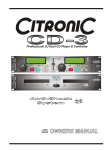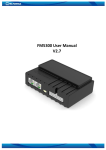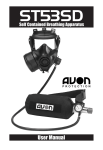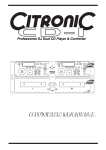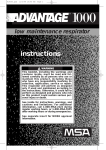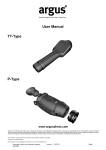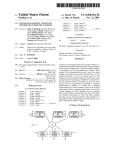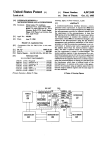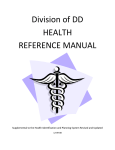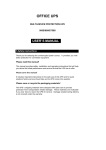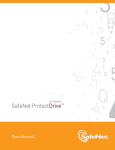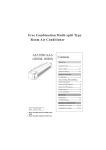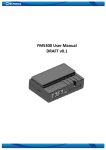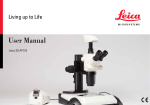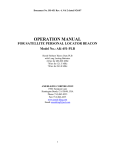Download ST-PAPR Operators Manual
Transcript
ST-PAPR User Manual User’s Manual for the ST-PAPR Powered Air Purifying Respirator The NIOSH approval label is located on a user’s instructions insert titled “ST-PAPR NIOSH Approval Information”. This insert is storedunder the front cover of this manual. Please keep this insert with this manual at all times. WARNING Disassembly of the components beyond the procedures described herein shall not be performed. Additional disassembly may cause component damage and shall only be performed by authorized personnel or the factory. Sales and Marketing-International Avon Protection Systems Hampton Park West, Semington Road, Melksham, Wiltshire, SN12 6NB Tel: +44 (0)1225 896705 Fax: +44 (0)1225 896301 www.avon-protection.com Email: [email protected] Sales and Marketing-USA Avon Protection Systems 1369 Brass Mill Road, Belcamp, MD 21017 Tel: 410-273-0124 Fax: 410-273-0126 www.avon-protection.com Email: [email protected] Manufacturer 922 Hurricane Shoals Road, Lawrenceville, GA 30043-4201 USA Tel: 678-495-3700 Toll Free: 888-474-7233 Fax: 678-495-3875 www.avon-isi.com Email [email protected] Part Number: 084171 Artwork Number: A49384 Issue A July, 2010 Issue A July, 2010 ST-PAPR Copyright 2010 Avon WARNING The ST-PAPR Powered Air Purifying Respirator shall not be used until the user has read and understod the user instructions supplied with this product. If the user has questions concerning the safe operation of this respirator, please consult the local trained supervisor or safety official. If the user instructions are not supplied to the user, a copy can be obtained by calling Avon-ISI: 888-474-7233. Use of Avon-ISI equipment, other than in compliance with the user instructions or use by personnel who are unqualified or untrained, is dangerous and the user may be exposed to serious bodily injury or death. The Avon-ISI ST-PAPR Powered Air Purifying Respirator must not be used in oxygen deficient (less than 19.5% oxygen) atmospheres. The Avon-ISI ST-PAPR must only be used by personnel having successfully completed a Quantitative Fit Test with the Facepiece PAPR combination. The Face seal can be adversely affected by a wide range of factors. These include but are not limited to: Facial Hair, Sideburns, Bangs and Headwear. Any change in these features must result in a repeated and successful quantitative fit test. Failure to carry out this repeat testing could affect protection factors and may result in serious bodily injury or death. Only Avon-ISI approved parts must be used. Do not modify or alter any parts. Only use in areas where a risk assessment has determined that the ST-PAPR provides suitable and adequate personal protection. Leave any contaminated area immediately if you experience difficulty in breathing, nose or throat irritation, dizziness or detect the taste or smell of the contaminant. 2 Copyright 2010 Avon ST-PAPR Table of Contents Preface . . . . . . . . . . . . . . . . . . . . . . . . . . . . . . . . . . . . . . . . . . . . . . . . . . . . . . . . . . . . . 2 1.0 General . . . . . . . . . . . . . . . . . . . . . . . . . . . . . . . . . . . . . . . . . . . . . . . . . . . . . . . . 4 1.1 General Cautions and Limitations . . . . . . . . . . . . . . . . . . . . . . . . . . . . . . . . . . 4 2.0 How to Use the Avon-ISI PAPR . . . . . . . . . . . . . . . . . . . . . . . . . . . . . . . . . . 6 2.1 Before Using the Avon-ISI PAPR . . . . . . . . . . . . . . . . . . . . . . . . . . . . . . . . . . . 6 2.2 Install Blower into Carrier . . . . . . . . . . . . . . . . . . . . . . . . . . . . . . . . . . . . . . . . . 6 2.3 Attach Harness to Carrier . . . . . . . . . . . . . . . . . . . . . . . . . . . . . . . . . . . . . . . . . 6 2.4 Installing the Battery Pack . . . . . . . . . . . . . . . . . . . . . . . . . . . . . . . . . . . . . . . . 7 2.5 BattAirflow Check . . . . . . . . . . . . . . . . . . . . . . . . . . . . . . . . . . . . . . . . . . . . . . . 8 2.6 Facepiece . . . . . . . . . . . . . . . . . . . . . . . . . . . . . . . . . . . . . . . . . . . . . . . . . . . . . 9 3.0 Installing the Canisters . . . . . . . . . . . . . . . . . . . . . . . . . . . . . . . . . . . . . . . . . 10 3.1 Airflow Test (Canisters installed) . . . . . . . . . . . . . . . . . . . . . . . . . . . . . . . . . . . . 10 4.0 Fitting Breathing Tube and Facepieces . . . . . . . . . . . . . . . . . . . . . . . . . . 12 4.1 Fitting Breathing tube to Facepiece . . . . . . . . . . . . . . . . . . . . . . . . . . . . . . . . . 12 4.2 Quantitative Fit Test . . . . . . . . . . . . . . . . . . . . . . . . . . . . . . . . . . . . . . . . . . . . . 12 5.0 Using the Avon-ISI PAPR . . . . . . . . . . . . . . . . . . . . . . . . . . . . . . . . . . . . . . . . 14 5.1 Donning the Blower Unit . . . . . . . . . . . . . . . . . . . . . . . . . . . . . . . . . . . . . . . . . . 14 5.2 Negative Pressure Leak Test . . . . . . . . . . . . . . . . . . . . . . . . . . . . . . . . . . . . . . 16 5.3 Using the PAPR in Contaminated Environments . . . . . . . . . . . . . . . . . . . . . . . 16 6.0 After Use . . . . . . . . . . . . . . . . . . . . . . . . . . . . . . . . . . . . . . . . . . . . . . . . . . . . . . . 18 6.1 Doffing the Avon-ISI PAPR . . . . . . . . . . . . . . . . . . . . . . . . . . . . . . . . . . . . . . . . 18 6.2 Removal and Disposal of Canisters . . . . . . . . . . . . . . . . . . . . . . . . . . . . . . . . . 18 6.3 Removal and Disposal of Battery . . . . . . . . . . . . . . . . . . . . . . . . . . . . . . . . . . . 18 7.0 Cleaning, Maintenance and Storage . . . . . . . . . . . . . . . . . . . . . . . . . . . . . 19 7.1 Cleaning the Respirator . . . . . . . . . . . . . . . . . . . . . . . . . . . . . . . . . . . . . . . . . . 19 7.2 Inspecting the Respirator before Storage and Re-use . . . . . . . . . . . . . . . . . . . 19 7.3 Storing the Respirator . . . . . . . . . . . . . . . . . . . . . . . . . . . . . . . . . . . . . . . . . . . 20 8.0 Accessories . . . . . . . . . . . . . . . . . . . . . . . . . . . . . . . . . . . . . . . . . . . . . . . . . . . . 21 9.0 Trouble Shooting . . . . . . . . . . . . . . . . . . . . . . . . . . . . . . . . . . . . . . . . . . . . . . . 27 10.0Warranty . . . . . . . . . . . . . . . . . . . . . . . . . . . . . . . . . . . . . . . . . . . . . . . . . . . . . . . 28 11.0Contact Information . . . . . . . . . . . . . . . . . . . . . . . . . . . . . . . . . . . . . . . . . . . . 29 ST-PAPR Copyright 2010 Avon 1 Preface Please read carefully all warnings and important points. Failure to properly use and maintain this product could result in injury or death. INTENT This manual is intended to acquaint owners and users with operation for the ST-PAPR and to provide important safety information and limitations. All information, illustrations and specifications in this manual are based on the latest product information available at the time of printing. The right is reserved to make changes at any time without notice. IMPORTANT ALL PERSONNEL USING THIS APPARATUS SHALL BE THOROUGHLY TRAINED BY A QUALIFIED INSTRUCTOR IN DONNING, OPERATION, INSPECTION AND EMERGENCY OPERATION. Equipment MUST be thoroughly checked and cleaned after exposure to harsh chemicals OR PARTICULATES. EQUIPMENT MUST ALSO BE COMPLETELY DRIED AND PROPERLY STORED. The procedures in this manual DO NOT render Avon Protection Systems or Avon-ISI liable for any losses or injury arising from any actions based on use of same. Spare parts and accessories are available through your local Avon Protection Systems or Avon-ISI authorized distributor. Suggested spare parts from other sources will void NIOSH approvals. Service beyond the scope of this manual is not recommended. If a problem persists, the apparatus should be removed from service, tagged for repair and forwarded to an authorized distributor or to the factory for evaluation and/or repair. TRAINING It is strongly recommended that the training program be consistent with Occupational Safety and Health Programs. Training and servicing programs are available upon request. NIOSH/OSHA WARNINGS The following warnings are given in accordance with accepted safety conventions and/or NIOSH/OSHA requirements, and apply to the use of breathing apparatus in general. HEALTH LIMITATIONS: Wearers of respirators should be certified medically fit prior to use. In addition, there are both physiological and psychological limitations which should be considered before using a respirator. They include, but are not limited to: * Emphysema * Chronic obstructive pulmonary disease * Bronchial asthma * X-ray evidence of pneumonia * Evidence of reduced pulmonary function * Coronary artery disease * Severe or progressive hypertension * Epilepsy (grand mal or petit mal) 22 Copyright 2010 Avon ST-PAPR Preface cont., * Pernicious anemia * Diabetes (insipidus or mellitus) * Breathing difficulties when wearing a respirator * Claustrophobia or anxiety when wearing a respirator * Abnormal EKG results from resting or stress tests * Punctured or ruptured ear drum These respirators are intended for entry into and work in atmospheres containing contaminates with adequate warning properties (ie. taste and smell) in concentrations less than those immediately dangerous to life and health (IDLH) and not oxygen deficient. FACIAL HAIR: Facial hair or any items which may interfere with the facemask-to-face seal, including the nosecup,or the operation of the exhalation valve, must not be allowed. These include beards, sideburns, mustaches, bangs, head coverings, or anything else that may interfere with the correct seal of the facemask and/or nosecup to the face. EYE WEAR: Eye glasses shall not be used when the temple bars interfere with the proper seal of the facemask to the face. NIOSH–Specific Industrial PAPR Cautions and Limitations A Not for use in atmospheres containing less than 19.5 per cent oxygen. B Not for use for entry into atmospheres immediately dangerous to life or health. C For entry, do not exceed maximum use concentrations established by regulatory standards. F Do not use powered air-purifying respirators if airflow is less than four cfm (115 lpm) for tight fitting facepieces or six cfm (170 lpm) for hoods and/or helmets. H Follow established cartridge and canister change schedules or observe ESLI to ensure that cartridges and canisters are replaced before breakthrough occurs. I Contains electrical parts that may cause an ignition in flammable or explosive atmospheres. J Failure to properly use and maintain this product could result in injury or death. L Follow the manufacturer’s Users Instructions for changing cartridges, canister and/or filters. M All approved respirators shall be selected, fitted, used, and maintained in accordance with MSHA, OSHA, and other applicable regulations. N Never substitute, modify, add, or omit parts. Use only exact replacement parts in the configuration as specified by the manufacturer. O Refer to Users Instructions, and/or maintenance manuals for information on use and maintenance of these respirators. S Special or critical Users Instructions and/or specific use limitations apply. Refer to Users Instructions before donning. ST-PAPR Copyright 2010 Avon 3 1.0 General The Avon PAPR respirator is a blower-assisted air-purifying respirator referred to as a Powered Air-Purifying Respirator or a PAPR. 1 The Avon PAPR when used with the FM53 Facepiece and Avon-ISI cartridges is NIOSH approved only for those contaminants and concentrations indicated by the label. The Blower Unit assists breathing by drawing air through the cartridges and delivering the purified air through a breathing tube to the facepiece. An Airflow Indicator, used to check for minimum airflow is provided with the ST-PAPR filtering system. Only a non-rechagreable Lithium Sulfur Dioxide battery is approved for use with the Avon PAPR. ! WARNING FAILURE TO CHOOSE A RESPIRATOR EQUIPPED WITH A CARTRIDGE SUITABLE FOR THE CONTAMINANT(S) IN THE ATMOSPHERE OR LIKELY TO BE RELEASED IN THE ATMOSPHERE DURING AN INCIDENT, MAY RESULT IN THE RESPIRATOR PROVIDING LITTLE OR NO PROTECTION AGAINST THE CONTAMINATED ATMOSPHERE, LEADING TO SERIOUS BODILY INJURY OR DEATH. THE AVON-ISI 033018 IS THE ONLY CARTRIDGE APPROVED FOR USE WITH THE AVON PAPR. 1.1 gENERAL cAUTIONS AND lIMITATIONs Prior to use, the user must read and fully understand: • These user instructions • The user instructions associated with the chosen Facepiece • The cartridge user instructions • Specific NIOSH Cautions and limitations (see Preface section) Prior to use, the user must recieve training in the use of the PAPR including, but not limited to, sizing and fitting procedures, pre-use checks, donning, seal check, use, doffing (removal), and after-use care. Prior to use, the user must have selected the correct size of facepiece in accordance with the fitting procedures given in the chosen facepiece user instructions. Prior to use, the user must confirm the correct fit and adjustment of facepiece and configuration of the PAPR using an acceptable fit test method and protocol (29 CFR 1910.134) such as ambient particle counting. (PortaCount®) Fit must be checked with the facepiece as an APR and with the PAPR with the Blower off. A fit factor of better than 2500 must be achieved for both applicants. The respirator must only be used in areas of incident where the risk assessment permits the use of powered air purifying respirators. Do not use in concentrations of contaminants that are immediately dangerous to life or health or are unknown or when concentrations exceed the use limitations for the respirator specified in applicable government regulations. 44 Copyright 2010 Avon ST-PAPR 1. Section Title 1.0 General cont., Avon ST-PAPR Major Components Voice Projection Unit 1 Airflow Indicator Carrier/Harness FM53 Protective Mask Blower/Breathing Tube with Control Wire & Switch Assembly + Battery Cartridges During use, the atmosphere must be monitored for the level of contamination and provision must be made for the withdrawal of personnel in the event that the contamination level increases to immediately dangerous to life and health (IDLH) levels. Do not use the ST-PAPR respirator for fire fighting, in oxygen-deficient atmospheres (<19.5% oxygen), or for protection against airborne contaminants for which the selected cartridge does not provide protection. New Lithium-Sulfur Dioxide batteries will provide flow of over 115 lpm for up to 8 hours. Use beyond this time is not recommended. The user must monitor and record battery use to ensure that the battery hours used is known. The Avon ST-PAPR respirator contains a battery and may not be taken into or used in atmosphere containing flammable or explosive gases, vapors, or dust when the concentration of such contaminants is near or above the lower flammable limit (LFL). Keep the cartridges sealed until fitted to the respirator just prior to use. If either cartridge becomes damaged, or water logged, both cartridges should be replaced immediately. Cartridges become ineffective if immersed in or heavily soaked in water. S - Special or Critical User’s Instructions The respirator facepiece should be kept in it’s protective bag on it’s support and in it’s storage bag at all times except when worn or maintained. The Blower must be stored with the Green Caps/plugs in place except when worn or maintained. The breathing Tube must remain attached to the Blower when stored with the end covered by the green cap. The cartridge must remain sealed until fitted to the blower prior to use. ST-PAPR Copyright 2010 Avon 5 1. 2.0Section How toTitle Use the Avon ST-PAPR 2.1 Before Using the Avon ST-PAPR Perform all required pre-use inspections, checking the condition and integrity of all components. 2 Make sure only those cartridges and facepieces that appear on the NIOSH Approval Label are used. Blower Unit Always use two NIOSH approved cartridges Note: The blower is shipped with the Breathing Tube/Control Wire atached. This assembly should not be removed except by a trained technician. The assembly should be stored in this configuration. 2.2 Install Blower into Carrier (If needed) Slide blower into carrier with the holes for the cartridges aligned and the outlet hole (breathing tube) on end pointing towards the end of carrier with 2 straps. 2.3 Attach Harness to Carrier (If needed) When properly attahed and adjusted, the blower should be located at the upper/middle of back. 66 Copyright 2010 Avon ST-PAPR Carrier 2.0 How to Use the Avon ST-PAPR 2.4 Installing the Battery Pack Blower Unit When using the disposable Lithium Sulfur Dioxide battry packs, the black battery cap provided with the Avon ST-PAPR Blower must be used. The battery Cap assembly has a lanyard. This can be secured via a split ring at the end of the lanyard to the hole in the blower housing to prevent loss. Install the Battery Pack into the battery compartment of the Blower Unit, as follows: 2 Set the Blower toggle switch to the OFF position. Remove the battery cap assembly from the PAPR Blower by turning counter-clockwise. + Remove the battery from it’s packaging. Inspect the battery for signs of damage. Check that the correct battery cap is attached by the lanyard to the Blower housing Battery CAUTION BE SURE THE SWITCH IS SET TO “OFF” POSITION BEFORE INSTALLING OR REPLACING THE BATTERY. DAMAGE MAY OCCUR TO THE BATTERY IF SWITCH IS “ON” WHEN BATTERY IS INSTALLED.. WARNING DO NOT USE ANY BATTERY WHICH SHOWS SIGNS OF DAMAGE, SUCH AS BULGING, SWELLING, DISFIGURATION, A SWOLLEN PLASTIC WRAP, LIQUID IN A PLASTIC WRAP. THE LITHIUM-SULFUR DIOXIDE (LISO2) NON RECHARGEABLE BATTERY USED IN THIS EQUIPMENT CONTAINS PRESSURIZED SULFUR DIOXIDE (SO2) GAS. THE GAS IS TOXIC AND THE BATTERY MUST NOT BE ABUSED IN ANY WAY WHICH MAY CAUSE THE BATTERY TO RUPTURE. DO NOT HANDLE THE BATTERY DIRECTLY IF YOU DETECT AN ODOR SIMILAR TO VINEGAR OR ROTTEN EGGS. SUCH ODOR INDICATES EXPOSURE TO BATTERY GAS LEAKAGE, WHICH CAN LEAD TO SERIOUS BODILY INJURY OR DEATH.. Install the Battery into the battery compartment in the Blower Unit with the contact end (metal ring) first. Replace the Battery Cap Assembly by screwing clockwise onto the Blower unit and complete the Battery Airflow check. ST-PAPR Copyright 2010 Avon 7 2.0 How to Use the Avon ST-PAPR 2.5 Battery Airflow Check 2 Battery Airflow Check - Without Canisters Test the operation of the Blower Unit with breathing tube attached using the supplied Airflow Indicator as follows: Inspect the Airflow Indicator to verify that the red ball moves freely within the column. Remove the green sealing plugs from the outlet and canister mounting ports of the Blower Unit. Retain these plugs for blower storage. Insert the Airflow Indicator into the Breathing Tube Outlet. It should snap in place. Position the Air-flow Indicator in an upright position with the Breathing Tube straight (on surface). Turn the PAPR Blower ON, make certain inlet holes are not blocked. Observe the position of the ball in the Airflow Indicator. With the Blower Unit running and no cartridges installed, the red ball will go to the top of the indicator. Failure to do so indicates a faulty battery. Replace and recheck. If airflow check continues to fail, tag the respirator as needing repair and remove from service. Turn the PAPR Blower off, remove the Airflow Indicator, and reinstall the green plugs in the outlet of Breathing Tube and the cartridge mounting ports until you are ready to use the respirator. 88 Copyright 2010 Avon ST-PAPR 1. Section Title 2.0 How to Use the Avon ST-PAPR Plus, the visor offers excellent field of view, visual awareness and weapon sighting capability. The patented exhalation assembly with twin valves must be in APR mode only. 2.6 Facepiece 2 Lever Valve Cassette Assembly (VCA) PAPR MODE Variable Resistance Exhalation Unit (VREU) The standard FM53 facepiece assembly has four-point adjustable head harness. The facepiece standard seal has a blended shape to ensure a proper fit. A standard inner-mask nosecup reduces dead air space and CO2 buildup. It is intended that this facepiece may be used in PAPR mode. Ensure the lever of the valve cassette assembly is fully rotated to the vertical position and the lever is aligned with the solid rectangle at the 12 o’clock position for PAPR mode. The FM53 provides the highest level of protection and comfort in the most dangerous environments. The unique polyurethane visor design is highly flexible and is both scratch and impact resistant. When the VPU is in place (section 8) the outer tab of the lever will be at 1 o’clock. ST-PAPR Copyright 2010 Avon 9 3.0 Installing the Cartridges 3.0 Installing the Cartridges Install the cartridge as follows: 3 NOTE: The Avon ST-PAPR respirator utilizes two approved Avon cartridges. Two (2) new cartridges must be installed before each use. The cartridges are one time use only and must be disposed of after each use. (see Section 6) Remove the protective green plugs from the blower inlets and outlet. Retain these plugs for blower storage. Inspect the gaskets in each of the cartridge ports. If a gasket is damaged or missing, replace with Avon P/N 70501/242. Gaskets must be present and in good order in the inlet port, otherwise the cartridge will not seal properly. Remove both cartridge from their packaging. CAUTION Cartridges are intended for one time use only. Cartridges are considered to have been put in service when they are removed from their packaging. Attach both canisters to the Blower Unit by screwing into cartridge ports until hand tight. WARNING Do not over tighten cartridges. Over tightening may distort the gasket resulting in leakage that may expose the wearer to substances which can cause serious personal injury or death. 3.1 Airflow Test - Cartridge Installed Using the Airflow Indicator, test operation of unit with cartridge in place, as follows: Inspect the Airflow Indicator to verify that the red ball moves freely within the column. Insert the Airflow Indicator into the Breathing Tube Outlet until it snaps in place. Turn on the Blower Unit. 10 10 Copyright 2010 Avon ST-PAPR 1. Section Title 3.0 Installing the Cartridges Place the Blower Unit on a horizontal surface with the breathing tube straight so that the Airflow Indicator is approximately vertical, observe the reading on the Airflow Indicator. Acceptable performance shall be indicated by the position of the red ball being above the line marked on the outside of the column. (With fresh cartridges and a new battery, the red ball should rise above the marked line). Battery Airflow Check With Cartridges Installed 3 Turn the Blower Unit off and remove the Airflow Indicator. ST-PAPR Copyright 2010 Avon 11 4.0 Attach Facepiece and Test WARNING Failure to verify proper air flow from the Blower Unit may result in reduced performance of the unit, leading to serious personal injury of death. 4 4.1 Fitting Breathing Tube to Facepiece WARNING Before assembling the Avon ST-PAPR system the user must be properly sized and fitted to the chosen facepiece according to the procedures given in the facepiece user instructions. Failure to check fit may result in subsequent leakage and consequent injury or death. Ensure that the facepiece cartridge mount gasket is present and in good condition. Do not use if missing or damaged. See relevant facepiece user Instructions. Attach the Breathing Tube (right angle connector end) to the facepiece cartridge mount. Screw in until hand tight. Note that the tube has a swivel connection that allows its position to be adjusted to the most suitable angle for the wearer after donning the facepiece. 4.2 Quantitative Fit Test WARNING Do not over-tighten the Breathing Tube Connector. Overtightening may distort the gasket resulting in leakage that may expose the wearer to substances that can cause serious personal injury or death. A fit test must be completed prior to first use and a minimum of annually thereafter. WARNING The user must be properly fit tested to the respirator before use. Failure to check fit may result in subsequent increased leakage and consequent injury or death. The fit test must be completed for the facepiece as an APR and for the facepiece configured with the PAPR with the Blower off. The quantitative fit results only apply to the user with the chosen breathing tube routing. 12 Copyright 2010 Avon ST-PAPR 4.0 Attach Facepiece and Test The user must confirm the correct fit and adjustment of the ST-PAPR using an acceptable fit test method and protocol such as ambient particle counting (PortaCount®). A fit factor of better than 2500 must be achieved. Quantitative fit testing with the PAPR (blower off) must insure that the hose or blower position do not snag or dislodge the facepiece. The Hydration System provides an easy method of sampling air from within the respirator during quantitative fit testing. A fit test adaptor that connects to the drink tube is available from Avon. See Facepiece User Instructions. 4 Note: A successful quantitative fit test result on its own does not assure the correct size of mask has been chosen. The trained fitter/supervisor must ensure that eye position, facial contact, harness position and facepiece firmness are correct before confirming facepiece choice. ST-PAPR Copyright 2010 Avon 13 5.0 Using the Avon ST-PAPR WARNING 5 Donning, doffing, and obtaining and checking for proper facepieces seal must be done in an area known to be free of contaminants. The respirator user must have practised this procedure before attempting to use the respirator for respiratory protection. Failure to do so may result in serious bodily injury or death. The Avon ST-PAPR must only be used by personnel having successfully completed Quantitative Fit Test with the Facepiece STPAPR combination. Recommended Blower Arrangement 5.1 Donning the Blower Unit Don the Blower Unit as follows: • Examine the Breathing Tube Assembly to verify that it is properly connected to both facepiece and the Blower Unit. • Examine the canisters to verify that they are properly installed to the Blower Unit. • Confirm that a successful airflow test was completed. • Don the harness with the Blower Unit such that the Breathing Tube is located at the top of the Blower Unit. Fasten the chest strap and adjust the harness until unit is positioned as shown. 14 14 Copyright 2010 Avon ST-PAPR 5.0 Using the Avon ST-PAPR During use Avon recommends that the Blower Unit is positioned in the centre of back, with the hose routed over the left or right shoulders as appropriate. 5 Ensure the lever of the valve cassette assembly is fully rotated to the vertical position. Attach Breathing Tube to mask. Pull outward to ensure it is not cross threaded into the facemask. Don the facepiece in accordance with the instructions given in the chosen facepiece user instructions. Adjust the net harness by pulling back on the lower straps first before adjusting the top straps. Swivel the hose connection to the most comfortable position that provides unrestricted head movement, ensuring that there is no snagging or excess tube in the Breathing Tube routing. IMPORTANT DO NOT OVER-TIGHTEN THE FACEMASK. doing so MAY CAUSE DISCOMFORT OR FACEMASK DEFORMATION AND LEAKAGE. WARNING FOLLOWING THE SAFETY CHECKS MUST BE PERFORMED BEFORE ENTERING A HAZARDOUS AREA. FAILURE TO PERFORM THESE CHECKS MAY RESULT IN RESPIRATORY INJURY OR DEATH. ST-PAPR Copyright 2010 Avon 15 5.0 Using the Avon ST-PAPR WARNING Failure to perform a satisfactory negative pressure leak check may result in little or no respiratory protection and may expose the wearer to substances that can cause serious personal injury or death. 5 5.2 Negative Pressure Leak Test Note: This check needs to be carried out with a partner or buddy. • With the Blower and Breathing Tube routed as tested in the quantitative fit test and the blower turned off, the partner must cover the inlet side of both cartridges by placing palms of hands or other airtight objects over cartridges inlets and press firmly to seal the inlets. The wearer must inhale slowly and hold breath momentarily. The respirator should collapse onto the face. Repeat with head movement to ensure that the breathing tube does not snag. • If the respirator does not collapse onto the face, run the hands quickly over the head harness and the edge of the respirator to ensure it is correctly fitted to the head and that there are no twisted straps. Check bottom strap tightness. Check the breathing tube for any snagging. • Check the cartridges are correctly fitted. • Repeat the test. • If leakage persists, DO NOT USE THE RESPIRATOR. 5.3 Using the ST-PAPR in Contaminated Environments The ST-PAPR respirator must be properly prepared for use, properly donned, and leak checked in an area known to be free of contamination before it can be used. Note: Additional protective clothing and protective head wear if used, must be arranged so that it does not interfere with the fit of the facepiece or movement of the breathing hose or restrict the airflow to the cartridges. 16 16 The safety officer in charge must determine the contaminants in the environment being entered and know that the cartridges provide protection. The safety officer must tell the user the expected life of the cartridges against the known contaminants. Copyright 2010 Avon ST-PAPR 5.0 Using the Avon ST-PAPR The Non-Rechargeable Lithium Sulfur Dioxide Battery will provide a flow of greater than 115 l/min for up to 8 hours. Use beyond this time is not recommended. WARNING Failure to properly adjust position of the Blower Unit with enough slack in the breathing tube may cause the face seal to be disturbed when the head is turned, reducing the protection offered by the respirator. Incorrect positioning of the Blower Unit in such a way that the breathing tube is excessively loose or excessively tight may result in the facepiece being pulled from the user’s face, exposing the useR to the hazardous atmosphere the respirator was intended to protect against, leading to serious bodily harm or death. 5 WARNING If, during use, the air flow from the PAPR Blower should noticeably decrease or stop completely, or if inhalation should become difficult, or the airborne contaminant is detected by odor, taste, eye irritation, or if any discomfort is felt during respirator use, or the battery compartment should become hot to touch, immediately turn the papr blower off. Do not remove the Facepiece, but continue to breathe through the respirator, and Immediately leave the contaminated area. Decontaminate if required, check the respirator. Failure to do so can lead to serious bodily injury or death. If a contaminant is detected by odor, taste, eye discomfort or other discomfort shortly after entering the contaminated environment, the user must leave the environment, decontaminate if necessary and recheck the respirator for proper fit. The safety officer must also verify that the cartridges are approved for the contaminants. If a contaminant is detected by odor, taste, eye discomfort or other discomfort after being in the contaminated area for a longer period of time, it will be necessary to leave the contaminated area and install new cartridges. If necessary, the user must decontaminate for this process. The air flow must be checked with the Airflow Indicator to see if the battery must also be replaced., ST-PAPR Copyright 2010 Avon 17 6.0 After Use 6.1 Doffing the Avon ST-PAPR WARNING The doffing process shall be performed only in a non-hazardous environment. Failure to do so may result in serious bodily injury or death. Exit the area requiring protection and if necessary carry out decontamination procedures in accordance with Federal, State and local environmental regulations. 6 When conditions are safe to remove and handle the respirator: • Move the selector switch or the remote toggle switch to the “OFF” position. • Doff the facepiece by loosening the 2 lower clamps and then pulling bottom of mask away from chin and over head. • Doff the Blower Unit by disengagimg the harness buckles by squeezing outside tabs of the buckle assembly toward the centre of the buckle. 6.2 Removal and Disposal of Cartridges Handle used canisters with extreme care. Cartridges may contain the contaminant that was in the atmosphere while the cartridges were being used and must be handled as a contaminated or potentially contaminated object. • Unscrew and remove the cartridges. Cartridges are intended for one use only and must be disposed of on termination of use. Do not dispose of cartridges as ordinary trash. Disposal of the cartridges must be in accordance with Federal, state and local environmental regulations. 6.3 Removal and Disposal of Battery Open the battery compartment by unscrewing (counter clockwise) the Battery Cap assembly and remove the Battery. The Non-Rechargeable LiSO2 battery must be disposed of on termination of use. Do not dispose of batteries as ordinary trash. LiSO2 Batteries must be discharged completely before disposal as follows: Remove the “WARNING” label from the side of the battery next to contact end. Attached to this label is a pull tab. Pull tab must be removed with label. Store battery with label removed for five (5) days to completely discharge. Dispose of depleted or damaged batteries in accordance with Federal, State and local environment regulations and in accordance with the material safety data sheet (MSDS) for the LiSO2 battery (to obtain an MSDS, please contact Avon). 18 18 Copyright 2010 Avon ST-PAPR 7.0 Cleaning, Maintenance and Storage WARNING Failure to properly clean and inspect the facepiece, breathing tube, carrier/harness and blower unit, may result in the respirator providing little or no protection and may expose the user to substances which can cause personal injury or death. Respirators must be cleaned, disinfected, and inspected after each use. After such cleaning and inspection, the respirator must be stored in a clean, dry area away from direct sunlight, and re-inspected during preparation for use before it is used again. TO AVOID DAMAGE TO THE VISOR, DO NOT PLACE THE FACEPIECE DOWN ON ROUGH SURFACES. 7.1 CLEANING FACEPIECE 7.1.1 7 Disconnect the Btreathing Tube from the facepiece by turning the handwheel counterclockwise. Wash the facepiece in cool to warm soapy water for no more than 10 minutes. Use a mild, non-detergent, dish washing soap. Do not use bleach. 7.1.2 Rinse facepiece thoroughly in clean running water, allowing the water to flow through the facepiece. 7.1.3 After rinsing, shake to remove excess water. Wipe dry with a soft, clean cloth. Use gentle air flow such as hair dryer on warm to blow through the exhalation valve and the inlet valve. 7.1.4 Ensure all head harness straps are fully extended, ready for use. WARNING IF THE APPARATUS IS LIKELY TO BE STORED AT TEMPERATURES BELOW FREEZING (32°F), THE FACEPIECE OR HOOD MUST BE THOROUGHLY DRIED. 7.1.5Place facepiece on support, in plastic bag and in protective bag when completely dry for storage. 7.2 Cleaning the Respirator Disconnect the Breathing Tube from the Facepiece. Remove the cartridges and battery from the Blower Unit, if still installed. Carefully wash the Blower Unit, Breathing Tube and Harness using a warm water solution (110ºF. maximum) containing mild detergent. Do not immerse the Blower Unit or getwater in the filter openings. A soft cloth may be used for scrubbing extremely dirty areas. Clean Breathing Tube sleeve, Breathing Tube connection and cartridge mounts for dirt that could prevent an airtight seal. Rinse thoroughly with clean water. NOTE: It may be necessary to remove blower from fabric carrier so that carrier can be washed to remove contamination. Same is true of sleeve over Breathing Tube. Contact factory for procedure to remove/replace Breathing Tube Sleeve. ST-PAPR Copyright 2010 Avon 19 7.0 Cleaning, Maintenance and Storage NOTE: If accidental immersion of the Blower Unit occurs, Blower Unit must be allowed to air dry thoroughly and then tested with the Airflow Indicator to verify that the motor was not damaged. 7.3 Inspecting the Respirator before storage and re-use Before assembly for storage and re-use, inspect the equipment for worn or damaged components that may prevent proper functioning of the respirator. Examine all hardware to verify proper condition of threads, couplings gaskets and seals. Examine facepiece in accordance with the user instructions for the chosen facepiece. Examine Blower Unit and Breathing Tube assembly for damage or cracks. Verify that there are no loose objects rattling inside Blower Unit. 7 Correct any deficiencies immediately, or tag the respirator as needing repair and remove from service. Verify that unit is working properly before storage by temporarily installing a battery and running the Battery Airflow Check (See 3.4). Remove the Battery after testing. 7.4 Storing the Respirator • Store the Avon PAPR as follows: • Store the facepiece in accordance with the procedures given in the instructions for use for the chosen facepiece. • On the Blower/Breathing Tube Unit, replace green plugs in the two canister mounting ports and replace the cap on the outlet of the Breathing Tube. • Store the Blower/Breathing Tube Unit in normal conditions (room temperature/ <60% relative humidity/away from direct sunlight) in a suitable box or storage bag. • Store the Batteries in normal conditions. The LiSO2 Battery is designed for extended shelf life when properly stored. The LiSO2 Battery is not rechargeable. WARNING Do not store unit with the battery installed. Always remove the battery from the blower unit for storage. Store the battery and the blower away from sunlight, heat or moisture. Keep this instruction booklet with the Avon ST-PAPR. 20 20 Copyright 2010 Avon ST-PAPR 8.0 Accessories 8.1 FITTING THE vOICE PROJECTION UNIT (vpu) 8.1.1 8.1.3 o remove the voice projection T unit: • Support the mask with one hand. Unplug the 3-pin connector from the ECP. • Grasp the voice projection unit with one hand, depress the locking lever and rotate the voice projection unit counter clockwise approximately 1/4 turn. he FM Protective Mask T has an ECP (External Communications Port) to attach the voice projection unit and other communications devices which use the internal microphone. • Pull away separating the voice projection unit from the mask. 8.1.2 o attach the voice projection T unit: • Bring the voice projection unit to the mask with one hand at approximately 45 degrees to the right. • Locate the mounting groove, insert the voice projection unit and rotate clockwise 1/4 turn. An audible click should be heard and the voice projection unit will not rotate any further. • Plug the 3-pin connector into the 3-pin ECP. ST-PAPR 8 Copyright 2010 Avon 21 8.0 Accessories 8.2 donning with protective hood WARNING 8.2.5Pull the harness tightly down at the rear. BEFORE DONNING MASK FOR THE FIRST TIME THE OPERATOR MUST BE PROPERLY SIZED AND FITTED! NOTE: ask must be properly stowed M prior to donning the mask. 8.2.1If used,the voice projection unit must be removed prior to donning the mask. It must be refitted before use. 8 8.2.2Remove head gear and glasses if worn. 8.2.3Pull hair back and insert the chin into the mask. 8.2.6Support the mask by locating and placing your hand over the VREU. 8.2.7Pull the cheek straps one at a time, ensuring straps lay flat against your head. Brow and temple straps are adjusted during fitting. Do not over-tighten. 8.2.4Grasp the head harness tab and pull the head harness over and to the back of your head. 22 22 Copyright 2010 Avon ST-PAPR 8.0 Accessories 8.3 doffing the mask with hood 8.3.1 hen the protective hood is W attached, release underarm strap fasteners, grasp the bottom of the protective hood and pull the hood up and over the head. 8.4 storage and transportation WARNING FAILURE TO PROPERLY STORE YOUR MASK COULD RESULT IN THE MASK NOT PROVIDING ADEQUATE PROTECTION WHEN USED NEXT! Safe storage and transportation of the mask is vitally important in maintaining its effectiveness. 8.4.1 8.3.2Slacken the cheek straps to their fullest extent. tore the mask in the NIOSH S approved Storage Bag, Liner and Form. 8.4.2Store and transport in a clean and dry environment within the guidelines of local established procedures. 8 8.4.3Do not store or transport the mask under heavy or sharp objects. 8.4.4Do not store or transport the mask where it could be exposed to extremes of temperatures or direct sunlight. 8.4.5Always clean and thoroughly dry the mask before storage. 8.3.3Grasp the front of the mask and pull the mask well forward and lift upwards then backwards off the head. ST-PAPR Copyright 2010 Avon 23 8.0 Accessories 8.5 stowage configuration with protective hood 8.6 Protective hood installation and removal 8.5.1Grasp the mask by the front module and place other hand inside the hood, grasping onto the harness. 8.6.1 8.5.2 Pull the hood over the mask. 8.5.3Carefully pull all excess hood material over the front of the mask. 8 Remove the voice protection unit. 8.6.2Place the protective hood on a flat surface with hood mask openings facing up. 8.6.3Insert the mask into the hood from the bottom with the mask facing up and aligned with the hood cutouts. 8.5.4Grasp the head harness and fold over the front of the mask. Ensure the straps of the head harness do not interfere with the mask seal. 8.5.5Hold onto the bottom of the hood and hang the mask upside down with the inside of the mask facing away from the body. 8.5.6Fasten and place the straps inside the hood. 8.5.7 old each of the hood flaps into F the center. 8.5.8 old the flap towards the outside F of the mask and secure the head harness. 8.6.4Remove the drink coupler from its receptacle and unstow the external drink tube. 8.6.5Route the drink coupler and external drink tube through the communications port of the hood. 24 24 Copyright 2010 Avon ST-PAPR 8.0 Accessories 8.6.6Unfasten the hook and pile straps 8.7.1Fit the frame tabs into the sockets on the hood and feed through the either side of the lens and fit the hood attachment slots on the mask. central stud in the center of the Refasten strap. top edge of the mask lens. 8.6.7Adjust the hood so that the rubber portion surrounds the VREU main body, communications port and the filter mount. 8 8.6.8Stow the drink coupler in the receptacle on the mask and ensure the external drink tube is properly stowed around the VREU main body 8.6.9 Replace the voice projection unit. 8.6.10Return mask to stowage configuration. 8.7.2Ensure the frame is positioned around the border of the lens. 8.7 Vision correction assembly installation, removal and adjustment Vision Correction Assembly (P/N: 7050/155) 8.7.3Adjust the height of the mounting frame using the adjuster. Complete vision correction assembly with prescription lens is available from Avon; www.avon-prtection.com NOTE: valid prescription (within 1 A year) is required. When the vision correction system has been received, fit it to the mask as follows: ST-PAPR Copyright 2010 Avon 25 8.0 Accessories 8.8 Using outserts 8.8.9 o remove, grasp the top and T bottom of the outsert and gently rotate the bottom of the outsert up and away from the mask. A variety of outserts are available to meet operational requirements. 8.8.1 8 lear outsert assembly (for C general use). 8.8.2 unlight outsert assembly (for S high UV situations). 8.8.3 lueblocker outsert assembly (for B glare). WARNING ENSURE THAT IF REMOVING OUTSERTS IN A CONTAMINATED ENVIRONMENT THAT YOU HOLD THE MASK AGAINST YOUR FACE WITH YOUR FREE HAND TO ENSURE THE SEAL OF THE MASK IS NOT BROKEN! 8.8.4Grasp the top and bottom of the outsert with both hands. 8.8.5 ilt the outsert with the bottom T up and align outsert over the eyelens. 8.8.6Align the locking tabs on the ends of the outsert with the receptacles on the mask and gently rotate the outsert down pushing the locking tabs into the receptacles. 8.8.7Ensure the locking tabs are secured to the mask assembly. 26 26 Copyright 2010 Avon ST-PAPR 9.0 Trouble Shooting TROUBLESHOOTING GUIDE PROBLEM POSSIBLECORRECTION CAUSE High exhalation force Low or no air flow inside facemask 1. VREU (Variable Resistance Exhalation Unit) in SCBA mode 1. Dead battery 2. Cartridges saturated 3. Cartridge covers not removed 4. Switch in different position 5. Kink in Breathing Tube 1. Rotate VREU lever counterclockwise to vertical position 1. Replace battery 2. Replace cartridges 3. Remove covers 4. Depress “on” position of remote switch, turn rotary switch to on position. 5. R eposition PAPR and check airflow 9 IF USER CORRECTIONS DO NOT RESOLVE THE PROBLEM, TAG UNIT "OUT OF SERVICE" AND GIVE TO QUALIFIED SERVICE TECHNICIAN. ST-PAPR Copyright 2010 Avon 27 10.0 Warranty IMPORTANT WARRANTY INFORMATION: EACH PRODUCT IS SHIPPED WITH A WARRANTY CARD. TO RECEIVE TECHNICAL UPDATES ON THIS PRODUCT YOU MUST REGISTER ONLINE OR COMPLETE AND RETURN THE LOWER PORTION OF THE WARRANTY CARD. Register your equipment online at www.avon-isi.com 10 28 28 Copyright 2010 Avon ST-PAPR 11.0 Contact Information Contact Information In the event of a product concern, contact your authorized distributor or Avon Protection Systems, who will provide the necessary information for issue resolution. To report any serious concerns or to speak with a certification organization, use the following contact information: Avon Protection Systems Hampton Park West Melksham, Wiltshire SN12 6NB Telephone:+44 (0) 1225 896705 Fax:+44 (0) 1225 896301 e-mail:[email protected] web-page: www.avon-protection.com North American Sales Office Avon Protection Systems PHONE 888-AVON-440 11 Manufacturer Avon-ISI Phone: 888-474-7233 ST-PAPR Copyright 2010 Avon 29
































